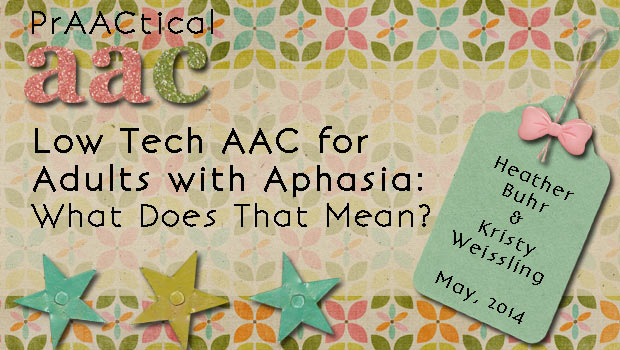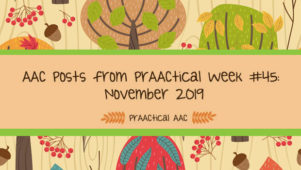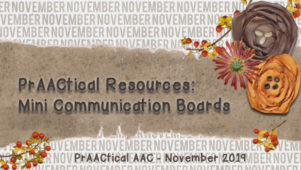Low Tech AAC for Adults with Aphasia: What Does That Mean?

Aphasia Awareness Month is just around the corner, and getting us ready for that is this wonderful post on using low tech AAC with people who have aphasia. We’re delighted to welcome back our friend and colleague, Dr. Kristy Weissling, who is collaborating with Heather Buhr, to share some thoughts on this topic.
:::::::::::::::::::::::::::::::::::::::::::::::::::::::::::::
For many, the term Augmentative and Alternative (AAC) brings to mind technology, speech-generating devices, and now – more than ever before – iPads. But as we know, AAC encompasses much more than that. We all use AAC when we make facial expressions or gestures, use symbols or pictures, or write. We would like to explore AAC and more “low-tech” options that help our clients express their thoughts, needs, wants, and ideas. Low-tech strategies can range from the use of written choice, to communication boards, to communication books.
In this article we will specifically address communication books. We admit, the term “communication book” can be an ambiguous term and needs a proper definition before we dive in too deep. To begin, let’s separate a communication book from a memory book. In our experience the two are often confused. The two are similar in the sense that they may include pictures, text, maps, icons, etc. bound together in a book format. However, the difference lies in their purpose; the memory book is an external cognitive aid meant to assist with cognitive deficits, specifically memory and perhaps executive function. Most of the time It is used by an individual with memory loss alone and is not accessed by other people. Memory books are frequently used with individuals who are experiencing cognitive challenges (e.g., TBI, dementia). They orient the individual to what they have done in the past (e.g., retrospective memories) or things they need to do in the future (e.g., prospective memory). A communication book is an external communication aid. It is used between two people for the purpose of sharing a message. It is used to support the communication of its users. Pictures or written text in the communication book are a reference point between the individual with aphasia and his/her communication partner. The entry in the book can set the conversation topic or assist in the communication of a specific message. The difference between these two books as we said is the purpose. A memory book is a SELF-reference; a communication book is “community” reference.
Let us give you a specific example of flexible individualized communication book use. Someone using a communication book may show his/her communication partner a message about visiting family in Wisconsin (e.g., picture of Wisconsin, text entry, picture). Giving the communication partner a reference point allows the individual with aphasia to independently initiate a topic and shift conversation towards something he/she would like to discuss. A well-trained partner might then use basic choice strategy to expand on the topic, refine it, and update it. When the person with aphasia initiates the topic and communicates his/her own ideas, naturalness and self-advocacy may be restored.
From a resource allocation (theoretical) point of view, communication books may decrease the overall cognitive-linguistic load on the individual with aphasia. For example, reflect on all the cognitive processes required when sharing with someone what you did last week: (1) you recall the past event (e.g., who was it, where was it, when was it), (2) you generate the appropriate language to describe the event, (3) you take into consideration what the listener may or may not know, (4) you manage the conversation (e.g., know when to share more details, or when sharing too much). The person with aphasia is naturally allocating many of their resources to getting the language message through a system that isn’t working properly. When a communication book is used to share a message, the linguistic load is decreased because the language from is (e.g., went to Wisconsin) right in front of them. This frees up additional resources for managing the conversation or taking into consideration what the listener already knows. Additionally, with the multimodal cues (e.g., pictures, text, map of Wisconsin, symbols) the individual may be primed for more accurate speech-language production. For those with fluent aphasia, the communication book may work as an anchor in conversation and may help manage perseverations and circumlocutions.
In addition to the linguistic and conversational benefits of communication books, we have also found some practical benefits. First, the cost of a communication book is significantly lower than some high-tech AAC options. For example, we typically use pocket calendars as our communication books (stay tuned for more on this later in the month!), or they can be completed with materials readily available in most clinics (paper, binders, laminator sheets). Additionally, clinicians can conduct a trial with a communication book with relative ease (e.g., doesn’t take long to put together, can be easily changed). For many of individuals (though not all!) working with a high-tech AAC device may be intimidating and difficult. Lastly, communication books offer flexibility and the opportunity to personalize content to meet the needs of the client and the family. Both the client and the family can add content easily to the communication book with some training. Personalization of the content of a communication book is KEY. This is where the simple nature of a communication book is a huge plus.
Now we have established what a communication book is and what it is not, we would like to share with you just how we are making our own communication books. As mentioned, stay tuned, we will follow with another article on how we make our communication books. Look for Low-Tech AAC for Adults with Aphasia: What does that look like?
Filed under: PrAACtical Thinking
Tagged With: aphasia, communication book, Heather Buhr, Kristy Weissling, low tech
This post was written by Carole Zangari





1 Comment
Excellent write up. Kindly notify regarding all your posts.
Thankyou